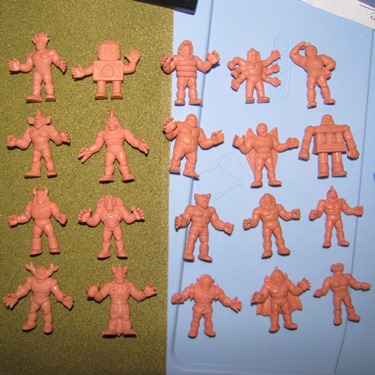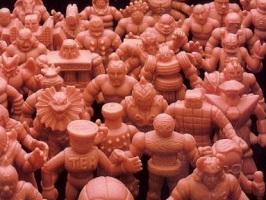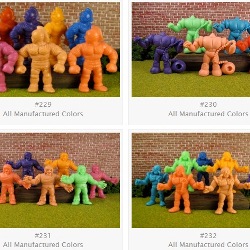Has collecting M.U.S.C.L.E. figures changed less than I thought? Yes and no.
This lot of 20 utterly pedestrian M.U.S.C.L.E. figures sold for $0.43 per figure. Since 2002 I don’t think I have met a M.U.S.C.L.E. collector that would have argued that was anything other than a fair deal – possibly bordering on a good deal.
It actually makes me happy to see this. I plan on refunding the buyer’s money (minus the shipping).
If the core of M.U.S.C.L.E. collecting hasn’t changed, then what has?
The MRT still applies. And situations like the SGS and its $3,113 impact will always exist. M.U.S.C.L.E. collecting will never evolve significantly enough for these things to change. I don’t think that is necessarily a bad thing – even if collectors don’t always like it.The thing that has changed is perfect transparency. The transparency to see a seller’s fear; the fear that their belief is wrong.
Let me explain.
M.U.S.C.L.E. collectors have often disagreed on prices. It has been a hallmark of M.U.S.C.L.E. collecting. Since the creation of the classification system in 2009 the use of Class A has been a strong selling point.
But most people that assign extra value to the Class A designation probably never read the final paragraphs in the guide’s introduction:
Quoting my own writing; I nominate myself for AOTW.There will be opponents of the idea that Class A figures are not rare. They will most likely cite how the figures can be difficult to find, that they do not turn up on auction websites often, and that they are often sold for prices of $50 or more. These examples are all valid. The author of this guide sold a Purple 154 for $220 in a message board auction, however the auction was driven by multiple factors: (1) a desirable figure; (2) impatience; and (3) aggressive collectors looking for an elusive piece.
However, this author acquired two Purple 154 figures for less than $5 combined only months earlier. Additionally, there are figures like Red 38. This figure is also a Class A figure, however this figure garnered little interest. At the time of publication this figure had received zero offers to be either traded for or bought.
Class A figures are not automatically valuable. The value of any figure is ultimately driven by some combination of: Impatience, Funding, Desire, Competitiveness, and Ignorance. Each potential buyer will have different levels of each factor.
This guide is designed to consolidate all of the available M.U.S.C.L.E. information into one easy-to-use guide for collectors. Remember, these rankings do not imply any financial value. There’s a fine quote from a noted art collector named Charles Saatchi:
Nobody can give you advice after you’ve been collecting for a while. If you don’t enjoy making your own decisions, you’re never going to be much of a collector anyway.
Good luck! Enjoy the hunt – it’s far more satisfying than the catch!
Anyways, the seller’s fear can be confirmed in the Class A price tags (and generally overpriced M.U.S.C.L.E. items). The seller lists the high price, because they are afraid they won’t get what they BELIEVE to be the price. It is why they can’t be convinced they are overpriced – or convinced of anything. Their belief is not based on evidence. It is based on their own belief in the price.
The SGS was started at $0.99. Even today there is a Class A Purple #152 starting at $0.99. Sellers are able to start M.U.S.C.L.E. auctions at $0.99 because they know, based on evidence, that having something truly valuable and desirable will guarantee M.U.S.C.L.E. collectors finding and paying for it.
“I can’t lose money on it.”
Toys are a terrible investment. Others will not pay for your own stupidity.
“But it’s worth $____.”
Fear. The seller fears that their belief is wrong.
“It has sold for $____.”
A meteor crashes through your roof. It is a unique experience, but it does not mean that you understand where it came from, why it happened, or even why it exists. Your meteor beliefs don’t mean anything. You have to digger deeper to truly understand the event. The same is true with many high priced M.U.S.C.L.E. items. You need to understand the event.
When I started collecting (around 2002) I considered the Nestle Quik tin to be my holy grail. At the time only one was known to exist. I never worried about owning it. Nothing would change if I owned it. Fortunately I was able to secure that tin in about 2009.
 Since 2009 I have found three other examples of the tin: one sold in an auction for $320; and two others were in private collections with sellers uninterested in selling (Example #1 and I can’t find my other example – aside from the original email). For me this is evidence that even “rare” items come around. It takes the fear away from “acting quickly or missing out forever.”
Since 2009 I have found three other examples of the tin: one sold in an auction for $320; and two others were in private collections with sellers uninterested in selling (Example #1 and I can’t find my other example – aside from the original email). For me this is evidence that even “rare” items come around. It takes the fear away from “acting quickly or missing out forever.”
If buyers don’t have the fear, the impatience, the competitiveness, or the ignorance, then a seller can’t capitalize on those feelings. Then buyers are left with perfect transparency. The transparency to see a seller’s fear; the fear that their belief is wrong.
But then we’re stuck with a bottleneck, because you can’t convince a believer.
M.U.S.C.L.E. toys.








#1 by Chris Krutsinger on August 19, 2015 - 4:50 pm
I think it should be worth mentioning that myself personally, and many other collectors too I would imagine, always figure in the price of shipping with each auction or buy it now to determine what I am willing to spend on something; especially in this day and age where many sellers boost shipping fees to try and cover their end for fear of weak bidding. In this instance, I would add the shipping cost to the winning dollar amount of the lot, which would then increase the average price per figure.
#2 by Chad Perry on August 20, 2015 - 7:59 am
Everyone has to pay shipping. As long as it is in the “fair” range I don’t think it is worth noting. Even a little bit high is kind of the price of eBay business. Every buyer considers shipping – but you have to pay it. It’s not an option. I have never factored it in to my own bids.
However – if shipping on the 20 figures had been $20, then it’s not a price-per-figure situation. It’s a “do-I-even-bid?” situation.